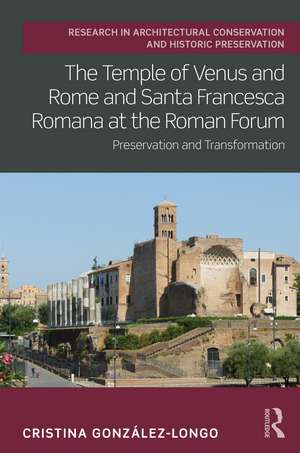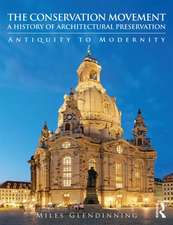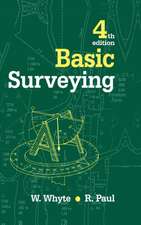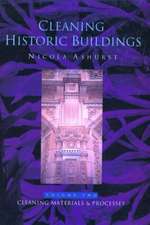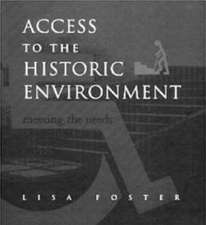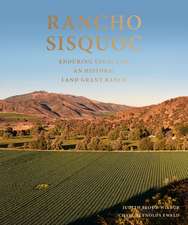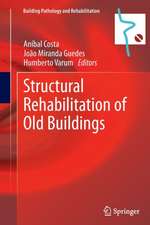The Temple of Venus and Rome and Santa Francesca Romana at the Roman Forum: Preservation and Transformation: Routledge Research in Architectural Conservation and Historic Preservation
Autor Cristina González-Longoen Limba Engleză Hardback – 30 dec 2020
The Temple of Venus and Rome and Santa Francesca Romana at the Roman Forum unravels the original designs and the subsequent interventions, including Giacomo Boni’s pioneering conservation of the monastery, carried out while excavating the Roman Forum in the early twentieth century. The projects are discussed in context to show their significance and the relationships between architects and patrons. Through its interdisciplinary focus on architectural design, conservation, archaeology, history and construction, this study is an ideal example for scholars, students and architects of how to carry out research in architectural conservation.
| Toate formatele și edițiile | Preț | Express |
|---|---|---|
| Paperback (1) | 245.01 lei 6-8 săpt. | |
| Taylor & Francis – 9 ian 2023 | 245.01 lei 6-8 săpt. | |
| Hardback (1) | 1000.27 lei 6-8 săpt. | |
| Taylor & Francis – 30 dec 2020 | 1000.27 lei 6-8 săpt. |
Preț: 1000.27 lei
Preț vechi: 1219.84 lei
-18% Nou
Puncte Express: 1500
Preț estimativ în valută:
191.45€ • 199.12$ • 160.44£
191.45€ • 199.12$ • 160.44£
Carte tipărită la comandă
Livrare economică 14-28 martie
Preluare comenzi: 021 569.72.76
Specificații
ISBN-13: 9781138896178
ISBN-10: 1138896179
Pagini: 238
Ilustrații: 14 Line drawings, black and white; 32 Halftones, black and white; 46 Illustrations, black and white
Dimensiuni: 152 x 229 x 18 mm
Greutate: 0.45 kg
Ediția:1
Editura: Taylor & Francis
Colecția Routledge
Seria Routledge Research in Architectural Conservation and Historic Preservation
Locul publicării:Oxford, United Kingdom
ISBN-10: 1138896179
Pagini: 238
Ilustrații: 14 Line drawings, black and white; 32 Halftones, black and white; 46 Illustrations, black and white
Dimensiuni: 152 x 229 x 18 mm
Greutate: 0.45 kg
Ediția:1
Editura: Taylor & Francis
Colecția Routledge
Seria Routledge Research in Architectural Conservation and Historic Preservation
Locul publicării:Oxford, United Kingdom
Public țintă
PostgraduateCuprins
Introduction 1. The First Architecture: The First Architecture: From the Velia to the Vestibule of the Golden House of Nero 2. The Place Transformed: The Temple of Venus and Rome of Hadrian 3. Decadence, Destruction and Recovery of the Place: The churches of Ss. Peter and Paul and S. Maria Nova and Alexander III 4. Architectural Preservation and Transformation, Patronage and Innovation: The Olivetan Order, Carlo Lambardi y Gianlorenzo Bernini 5. The New Conservation Ideology: Giuseppe Valadier y Giuseppe Camporesi 6. Conservation and Architectural Project: Giacomo Boni as pioneer of the the ‘Critical Conservation’ Conclusion: The Architectural Conservation Project: Preservation and Transformation List of References List of Figures Index
Notă biografică
Cristina González-Longo, RIBA SCA RIAS FHEA FRSA, is the Founder and Director of the MSc in Architectural Design for the Conservation of Built Heritage at the Department of Architecture of the University of Strathclyde, where she has also created and is leading the Architectural Design and Conservation Research Unit (ADCRU). Her research group deals with the challenges of conserving built heritage while allowing changes to adapt historic buildings for contemporary uses, as well as with the design of new buildings to conserve the environment, which requires an interdisciplinary approach. After graduating at the School of Architecture of the Technical University of Madrid (ETSAM), Cristina spent three years in Rome with a scholarship from the Italian Government to study architectural conservation at the prestigious Specialisation School of the Sapienza University of Rome. She is also a practising architect with over twenty years’ experience as a Chartered architect both in the UK and Spain, RIBA Specialist Conservation Architect (SCA) and member of the RIBA Conservation Register Assessment Panel. She has had a central role in taking decisions concerning historic buildings of outstanding national and international importance and wide experience in leading the design, management and procurement of award-winning architectural projects (both conservation and new-build). She was the project architect and resident architect of Queensberry House, a Category A Listed building, part of the new Scottish Parliament complex in Edingburgh (RIBA Stirling Prize 2005). She also designed Bowbridge Primary School in Newark, UK (RICS Sustainability Award 2009), with an innovative lamella glulam structure. She is the President of the ICOMOS (International Council on Monuments and Sites) International Scientific Committee on Education and Training (CIF).
Recenzii
Cristina González Longo has carefully and lucidly analysed one of the most interesting architectural "metamorphosis" in Rome, studied here for the first time in all its complexities, from Nero’s hall and Hadrian’s temple of Venus and Rome to its current configuration of the church of Santa Francesca Romana and the monastery of S. Maria Nova, occupied by the Olivetan order since 1352 and now also partially occupied by the offices of the Soprintendenza. With the support of many original illustrations, she has unravelled all the various architectural transformations over more than two millennia, situating them also within their cultural, theoretical and ideological context. A fascinating research which challenges existing praxis of architectural conservation.
Antón Capitel, Emeritus Professor of Architectual Design at the Technical University of Madrid (ETSAM), RIBA International Fellow and author of Metamorfosis de Monumentos y Teorias de la Restauracion
Perhaps only in Rome it is possible to understand that time does not flow, but accumulates. Mankind’s creations do not escape this rule. Architecture is made of bricks, stones, mortar, but also and above all of time. A famous and prominent church such as Santa Francesca Romana, very well known to locals and tourists visiting the Roman Forum, is actually the result of an overlapping of constructions, destructions and conservation interventions. Even its beauty is made of time. In the winding of a building on the other, from the great temple of Hadrian, to the solemn medieval church of S. Maria Nova, the sumptuous Baroque church and the intervention in the monastery by the conservation pioneer Giacomo Boni, different generations have followed one another, without ever completely erasing previous architectural layers. Cristina González-Longo has the great ability to unravel the complexity of this site and to explain it to those who are willing to listen. It allows us to understand that architecture is the only art form where past and present manage to dialogue among them, giving meaning to our future.
Claudio Varagnoli, Professor of Preservation of Built Heritage and Conservation at the University of Chieti-Pescara and the Italian Archaeological School of Athens. Member of Italy’s Superior Council of Cultural Heritage, and Roman.
González-Longo provides here a riveting account of the complex evolution of the great Olivetan monastery and basilica, Santa Francesca Romana, leading us for the first time through its integral relationship with the Temple of Venus and Roma, adeptly drawing throughout on primary and contemporary sources, literature and imagery and showing insightful command of the rich instruction they unravel. The author’s research revealed phases and aspects of the many engagements with the site unknown until now and which ensure the assessment brings new depth to our understanding of this monumental edifice. Conservation architects and historians, however familiar with the study of destruction, transformation, re-use and regeneration, will also find delight in these well-illustrated chapters in their perceptive discovery of a late seventeenth century emergence of conservation ideology. The monograph traces the development of the conservation discipline following Carlo Lambardi’s transformation of the medieval church, through respective ideologies in their application, showing lineage with the later thinking of Ruskin and SPAB, the influential, ground-breaking approach of Giacomo Boni in the early twentieth century and on to stratigraphic architectural conservation or design and the informed conservation we prize today. This is, most satisfyingly, a refreshing and exceptional biography of a building that leaves the reader complete with an intimate appreciation of the subject, its context and its immense significance.
Dr Deborah Mays, Head of Listing, English Heritage
Antón Capitel, Emeritus Professor of Architectual Design at the Technical University of Madrid (ETSAM), RIBA International Fellow and author of Metamorfosis de Monumentos y Teorias de la Restauracion
Perhaps only in Rome it is possible to understand that time does not flow, but accumulates. Mankind’s creations do not escape this rule. Architecture is made of bricks, stones, mortar, but also and above all of time. A famous and prominent church such as Santa Francesca Romana, very well known to locals and tourists visiting the Roman Forum, is actually the result of an overlapping of constructions, destructions and conservation interventions. Even its beauty is made of time. In the winding of a building on the other, from the great temple of Hadrian, to the solemn medieval church of S. Maria Nova, the sumptuous Baroque church and the intervention in the monastery by the conservation pioneer Giacomo Boni, different generations have followed one another, without ever completely erasing previous architectural layers. Cristina González-Longo has the great ability to unravel the complexity of this site and to explain it to those who are willing to listen. It allows us to understand that architecture is the only art form where past and present manage to dialogue among them, giving meaning to our future.
Claudio Varagnoli, Professor of Preservation of Built Heritage and Conservation at the University of Chieti-Pescara and the Italian Archaeological School of Athens. Member of Italy’s Superior Council of Cultural Heritage, and Roman.
González-Longo provides here a riveting account of the complex evolution of the great Olivetan monastery and basilica, Santa Francesca Romana, leading us for the first time through its integral relationship with the Temple of Venus and Roma, adeptly drawing throughout on primary and contemporary sources, literature and imagery and showing insightful command of the rich instruction they unravel. The author’s research revealed phases and aspects of the many engagements with the site unknown until now and which ensure the assessment brings new depth to our understanding of this monumental edifice. Conservation architects and historians, however familiar with the study of destruction, transformation, re-use and regeneration, will also find delight in these well-illustrated chapters in their perceptive discovery of a late seventeenth century emergence of conservation ideology. The monograph traces the development of the conservation discipline following Carlo Lambardi’s transformation of the medieval church, through respective ideologies in their application, showing lineage with the later thinking of Ruskin and SPAB, the influential, ground-breaking approach of Giacomo Boni in the early twentieth century and on to stratigraphic architectural conservation or design and the informed conservation we prize today. This is, most satisfyingly, a refreshing and exceptional biography of a building that leaves the reader complete with an intimate appreciation of the subject, its context and its immense significance.
Dr Deborah Mays, Head of Listing, English Heritage
Descriere
This book examines the influence of architectural design in the conservation of historic buildings by discussing in detail an important building complex in Rome: the Temple of Venus and Rome, the monastery of Santa Maria Nova and the church of Santa Francesca Romana.
